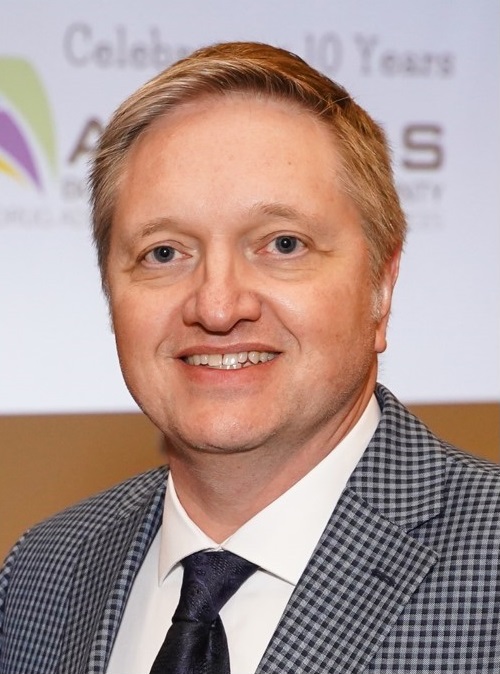Professional Development
Mailing Address
Cleveland State University
2121 Euclid Avenue
Cleveland, OH 44115
Campus Location
Urban Building
1717 Euclid Avenue
Cleveland, OH 44115
Ohio Certified Public Manager (OCPM) Program - Scott Osiecki
Ohio CPM Program | Curriculum | Flyer | Handbook | FAQ | Program Advisory Board | Program Alumni | Program Instructors | Program Staff | Video
Alumni Profile Series
Meet Scott S. Osiecki
Chief Executive Officer, Alcohol, Drug Addiction and Mental Health Services (ADAMHS) Board of Cuyahoga County
 What Academy did you graduate from? When?
What Academy did you graduate from? When?
Leadership Academy XIII, 2004
Tell us a little bit about your organization.
The Alcohol, Drug Addiction and Mental Health Services (ADAMHS) Board of Cuyahoga County is responsible for the planning, funding and monitoring of public mental health and addiction treatment and recovery services delivered to the residents of Cuyahoga County. Under Ohio law, the ADAMHS Board is one of 50 Boards coordinating the public mental health and addiction treatment and recovery system in Ohio. The Board is a quasi-independent part of county government, governed by a volunteer Board of 18 Directors and funded through Cuyahoga County's Health and Human Services levies and state, federal and grant funds. The Board contracts with provider agencies to deliver services that assist clients on the road to recovery.
Tell us a little bit about what you do.
As Chief Executive Officer of the ADAMHS Board of Cuyahoga County, I am responsible for the overall day to day operations of the organization, including communication with the volunteer Board Members; preparation of public Board Meetings; serving as the liaison between government officials; executing contracts for the provision of services supported by the board; hiring, supervising, and removing employees and consultants; advocating for changes, development and expansion to increase effectiveness of behavioral health, and being fiscally responsible to the taxpayers.
What was the most memorable part of the program?
The most memorable parts of the program were meeting, sharing, and learning from the experiences of other public sector and nonprofit professionals, the various instructors, sight visits, and having the support of the CSU team – including the late Dr. Vera Vogelsang-Coombs.
What was your favorite session? Why?
I can't pick only one session. However, the sessions on crisis communication, discovering various leadership styles, finding out your personality type through the Myers-Briggs assessment, and learning how to adapt your own communication style were some of my favorites.
What lessons did the Academy equip you with?
The ability to be confident with my communication and leadership skills, while realizing that improving in both and motivating individuals, is a continual process. It also helped me further analyze problems and possible solutions, as well as recognize the various leadership styles and potential for advancement in others.
How has the Academy positively impacted/added value to your professional life?
My participation in the Academy has definitely helped me achieve professional growth, and provided me with many of the skills that were needed for my advancement through the levels of responsibility from a Director to a Chief to the CEO of the ADAMHS Board. Many of my Executive Team members are graduates of the Academy, and I believe that their participation has also helped them advance to their current positions at the Board.
During your time in the program, what's one thing you learned about yourself that surprised or challenged you?
I am a detail person, but I learned that I was also a "big picture" person. This was revealed through the various sessions and exercises of the Academy, as well as the observations and encouragement of Academy staff to broaden my perspective.
In your opinion, what does a good public manager look like? In your opinion, what does a good public leader look like?
A good public manager is able to get the job done through the creative use of available resources, which includes utilizing talent in staff, developing partnerships with other public managers and the community, as well as paying attention to timelines and budgets of a program and/or project.
A good public leader goes beyond to include strategic planning and thinking about the "big picture" and how to achieve lasting results that can make a beneficial change for the organization and the community. Good public leaders also need to recognize the potential within existing staff and ensure that employees have the tools necessary to reach success.
Why are professional development opportunities important?
Professional development is a continual process since we are all working in an ever-changing environment. Opportunities, like the Academy, allows an individual who is serious about advancement to learn various skills and practice them is a safe environment.
What's one piece of advice you'd like to pass along to your fellow public managers?
Life in public service is rewarding, but can be difficult. You have to keep a good sense of humor, as well as a group of trusted colleagues you can use as a sounding board to bounce ideas and share common experiences. In addition, emotional learning is a journey that is important so that you can be able to better use emotions to achieve positive outcomes.
In your opinion, what's Ohio's best-kept secret?
The people. Ohioans have the ability to look beyond geographic and political differences and come together to adapt to all situations – from the unpredictable weather, to handling a pandemic.
Mailing Address
Cleveland State University
2121 Euclid Avenue
Cleveland, OH 44115
Campus Location
Urban Building
1717 Euclid Avenue
Cleveland, OH 44115